Planting cherries in spring: how to properly plant a seedling in open ground
Cherry is the most popular stone fruit crop found in our gardens. This is explained by its unpretentiousness and relatively uncomplicated tree care, as well as the great demand for fruits both fresh and canned (as preparations for the winter). But in order for the cherry to constantly bear fruit and not cause much trouble, it is first necessary to plant a fruit tree according to all the rules.
You will learn how to plant cherries correctly in spring, how to choose a good place for them in the garden and prepare a planting hole in this article.
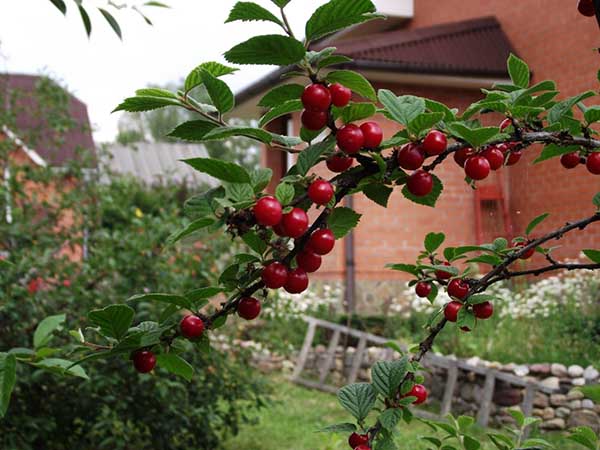
Content
- 1 When to plant cherries in spring, in what month: timing
- 2 Step-by-step instructions for planting cherries in the spring: proper preparation and direct planting of a seedling in a planting pit
- 2.1 Selecting a seedling and preparing it for planting
- 2.2 Optimal location
- 2.3 At what distance to plant
- 2.4 Required soil
- 2.5 Planting pit preparation: when to dig and what dimensions (depths)
- 2.6 How to prepare a nutrient mixture (substrate) or how to fill a planting pit
- 2.7 Step by step disembarkation guide
- 3 Further care for cherries after spring planting
When to plant cherries in spring, in what month: timing
The optimal time for planting cherries in the spring in the garden is the period before the budding of the tree, in other words, before it enters the growing season (i.e., the plant must still sleep).
At the same time, an important condition for spring planting is a positive air temperature, and not only during the day (it should already be +5), but also at night.
You should not wait for the ground to completely thaw out; it is very good to plant seedlings with an open root system immediately after the snow melts, but the ground has not yet had time to warm up very much.
Thus, it is highly desirable to have time to plant while the seedlings are still "dormant", otherwise it will definitely negatively affect their survival rate and disrupt their natural development cycle.
As for the approximate dates, depending on the climatic characteristics of the region, spring planting of cherries is recommended from late March-April to early May.
Advice! The best time to plant seedlings is cloudy and calm weather: early morning or late evening.
When is it better to plant - in spring or autumn
Important! Too late to plant seedlings in the autumn is also not recommended, because shoots must have time to mature well in order to successfully survive the winter.
However, if you are late, and frosts are expected within 1-2 weeks, then it is better to play it safe and postpone planting cherries until spring (you can save the seedling by digging it in the garden or planting it in a container and putting it in the basement).
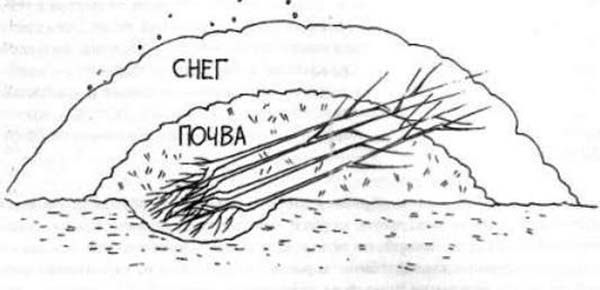
By the way! On the contrary, some gardeners adhere to the old rule that pome crops - apple and pear trees are best planted in autumn, and stone fruits - cherries, cherries, plums, apricots - in spring.
The fact is that stone fruit crops are considered less winter-hardy, therefore it is recommended to plant them in the spring, so that before winter they have time to take root and get stronger.
However, if you are a resident of the South of Russia, then this is not a matter of principle. It is a different matter if you are from a region with a harsher climate (zones of risky farming).
- In the process of growing a seedling, you can quickly respond to possible problems (diseases, pests, lack of moisture) and immediately take the necessary measures to eliminate them.
- The spring reserve of moisture in the soil allows the root system to adapt faster after planting and begin active growth.
- There is an opportunity to prepare the site in advance, in the fall, so the soil will have time to sink by the spring, and this will help to avoid deepening the root collar.
Note! Cherry seedlings with a closed root system can be planted all year round - from April to October, unless it is too recommended to do this in the middle of summer, when it is very hot.
Video: in what time frame is it better to plant seedlings of fruit and berry crops
Planting dates in spring in different regions
Naturally, depending on climatic features, the timing of spring planting of cherries in different regions will vary:
- So, in the South of Russia, cherries can be planted in the second half of March or early April.
- But the gardeners of the Middle Strip (Moscow region) should wait until the 2nd decade of April.
- In Siberia and the Urals, cherry seedlings should be planted in open ground only in late April-early May.

According to the lunar calendar in 2020
Choose the optimal date for planting seedlings can help you moon calendar.
So, favorable days for spring planting of cherries in 2020, according to the lunar calendar, are:
- in March - 26-29;
- in April - 11-15, 24, 25;
- in May - 2-10.
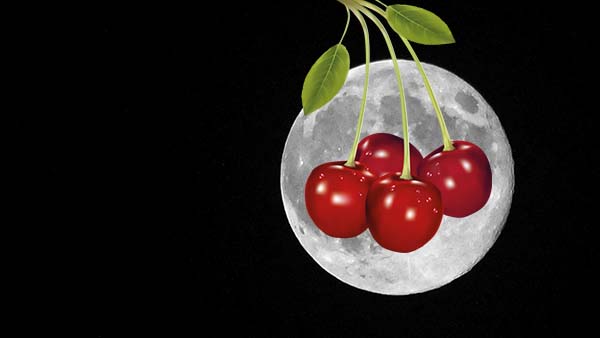
Of course, it is not always possible to get to the dacha on the appropriate days, so the main thing is not to plant cherries and any other crops on unfavorable dates according to the lunar calendar - the days of the New Moon and Full Moon, as well as the period when the Moon is in Aquarius, because it is a barren and dry sign - in italics.
Unfavorable days, according to the lunar calendar, for 2020 for planting cherry seedlings in spring, the following dates are:
- in March - 9,19-21, 24;
- in April - 8,15-17, 23;
- in May - 7,13-14, 22;
- in June - 5,9-11, 21.
According to the lunar calendar, from the magazine "1000 Tips for Summer Residents".
Step-by-step instructions for planting cherries in the spring: proper preparation and direct planting of a seedling in a planting pit
Planting, like any other procedure, requires adherence to the rules and recommendations, which guarantees a positive result.
Selecting a seedling and preparing it for planting
When choosing a seedling, you must give preference cultivars regionalized for your region, which has proven itself very well in your climatic growing conditionswho have sufficient the level of winter hardiness for your area.
Worth knowing! Saplings can be either with an open root system (OCS), and with a closed one (in a container).
Of course, it is better for beginners to take seedlings in a container, and experienced gardeners can also purchase from ACS.
In addition, a cherry seedling must have the following qualitative and quantitative characteristics:
- The general appearance of the seedling should be healthy, without signs of wilting, damage from diseases or pests.
- The seedling itself should not be older than 2 years, since at this age the seedlings adapt faster.
- The height of the seedling should be within 1-1.5 m (low-growing below, vigorous above): any deviation up or down indicates improper care of it or excessive application of nitrogen fertilizers.
- It must have a well-developed root system (without any growths and neoplasms), that is, in addition to the main root, there must be several lateral ones (the older the seedling, the more roots it has), the length of which can be about 20-25 cm, however, they should not be overdried and broken.
Even if you are buying a seedling with a closed root system, the lateral roots tend to stick out of the container.
Advice! To check that a seedling is indeed with a closed root system, it must be grasped by the trunk and shaken. If he fits tightly, everything is fine.
- In the lower part, on the trunk, you should clearly see the grafting site (the joint of the rootstock and the scion), which will guarantee that this is a varietal tree, and not a wild.
As a rule, the vaccination is done by budding method (they also say "grafted with an eye"), less often with a handle (ie copulation).
- It is also worth evaluating the quality of the upper part of the trunk (grafted part): the wood must be matured and strong, without any mechanical damage, sunburn, frost cracks and bark cracks. And the trunk itself should be flat and not curved.
Note! If the bark on the trunk peels off in places without damaging its integrity, then this is a sign of improper storage of the seedling in winter, which led to freezing, so you should not purchase it.
- It is highly desirable that the seedling does not have any signs of the beginning of the growing season, i.e. was in a dormant stage (the buds are asleep, there are no leaves).
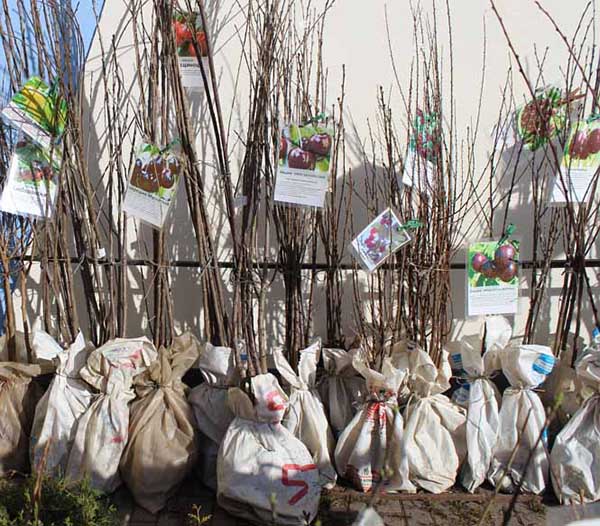
However, seedlings with a closed root system (in containers) in the spring are often sold already in the growing season. In this case, you also need to carefully evaluate their appearance, especially the color of the leaves.
Preparing for landing
Immediately before planting, the roots of the seedling should be washed from the old soil, then dipped in a clay talker, and then the tips of the roots should be renewed, slightly cutting them.This is all the more necessary to do this if the roots are too long, or you will notice that there are damaged, diseased and broken (to a healthy place).
Some gardeners recommend completely soaking the seedling in water (with the addition of Kornevin) for a day or at least an hour. This will help restore biological processes in the roots and saturate them with moisture, especially if you see that the roots are slightly dry (and this should never be allowed).
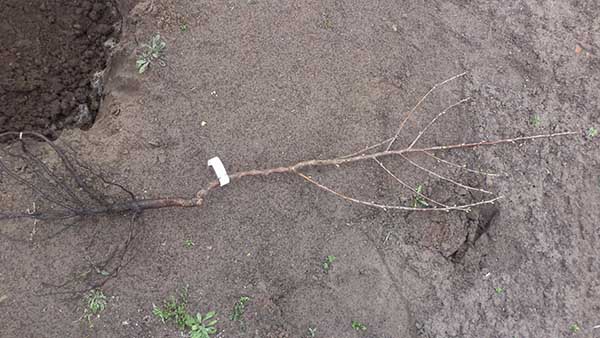
Optimal location
Cherry is considered a relatively thermophilic crop, so it prefers to grow in open and well-lit areas, but with mandatory protection from drafts.
The ideal option for planting cherries would be a place that will be protected from the drying winter winds on the north side. This can be your country house, some kind of outbuilding or a fence..
In this case, the tree itself, of course, should be placed on the south side (or at least from the south-west or west), so it will receive the maximum amount of sunlight.
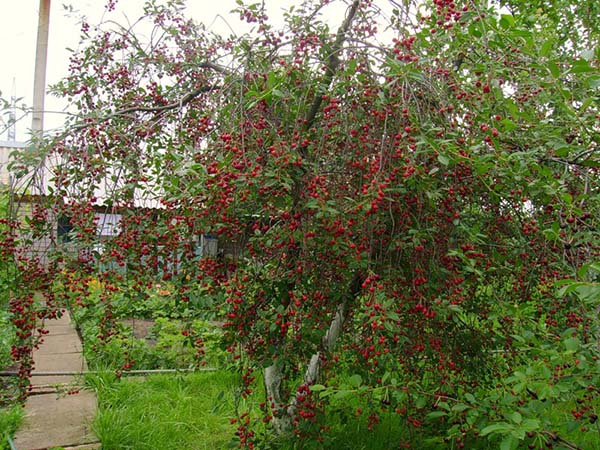
You should not plant cherries in lowlands and even more so wetlands.
In other words, at the landing site moisture should not stagnate in the springwhen the snow melts. Otherwise, the plant will simply underpin the root collar, and it will die.
By the way! Stone fruits (apricots, peaches, cherries) are crops with relatively "weak" root collars (in comparison with seed crops, the same apple trees), therefore, in the zone of risky farming, they are recommended to be planted on elevations (mounds).
The occurrence of groundwater in the area intended for planting should be at a level of 1.5 m from the ground surface.
If the groundwater is close, then you have no choice but to make an artificial embankment and plant a seedling on it.
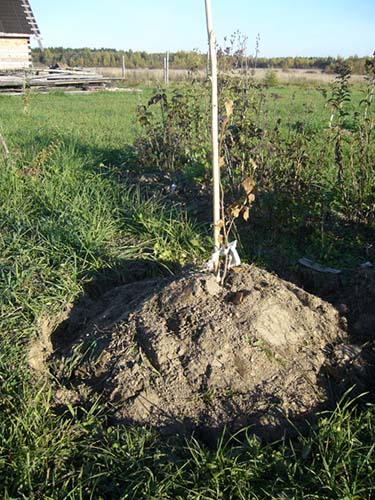
Important! Of course, cherries should not be planted near large spreading trees (especially nuts), as this will negatively affect their growth and productivity (if the seedling can grow and bear fruit normally at all).
At what distance to plant
Cherry, like any other fruit tree, needs its own individual space, therefore, when planting, it is necessary to maintain a distance between neighboring trees.
There are bushy and tree-like cherries. Their main differences are in height and the beginning of fruiting: bushy plants grow up to 2-4 m and begin to bear fruit 3-4 years after planting, tree-like ones - up to 5-6 m, and begin to bear fruit in 4-6 years.
Usually, more popular exactly tree cherries, therefore, they will be discussed below.
It is recommended to plant cherries according to the scheme - 4 by 3, i.e. distance between rows is 4 meters, between seedlings in a row - 3 meters. Accordingly, bushy ones can be planted about 1.5-2 times closer.
Note! Cherries require cross-pollination, in other words, you need to plant at least 2, and preferably 3 different varieties next to each other (the same varieties are not suitable for pollination), and it is necessary to have the same flowering period.
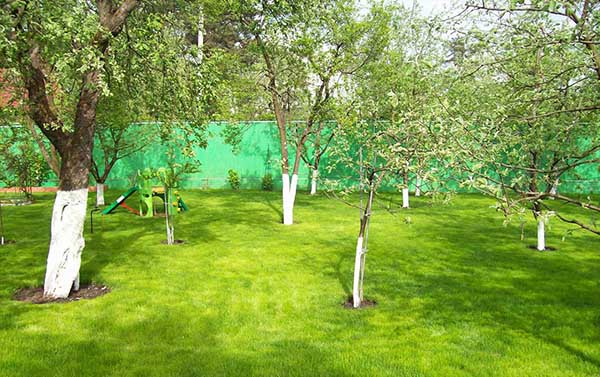
Remember! The closer you plant trees, the more difficult it will be for you to control their crown in the future, in other words, you will need regular and mandatory pruning, including summer pruning.
Required soil
Loamy (loam) and sandy loam soil, as well as light black soil, are perfect for growing cherries.
The soil should be sufficiently light, loose (it is good to let water and air pass to the roots) and have neutral acidity level.
All stone fruits love non-acidic soils and will thrive better in alkaline soils (7.5 pH) than even relatively acidic soils (5.5 pH).
Of course, less successful for planting cherries (and almost all fruit trees) is sandy and clayey soil... In this case, you will definitely need to do good drainage, and then most likely the culture will be able to take root, grow relatively successfully and bear fruit even under such conditions.
Important! When planting a seedling in excessively sandy soil, add a little clay and a lot of compost to it, and sand in clayey soil, this will help balance the composition of the soil.
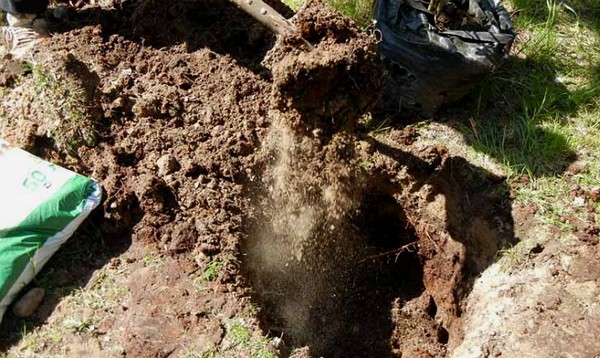
Advice! In a cold and harsh climate, as well as if the ground is heavy, or the site is very waterlogged and the groundwater is very close, then cherries (like any other fruit trees) are recommended to be planted on gentle hills ("According to Zhelezov").
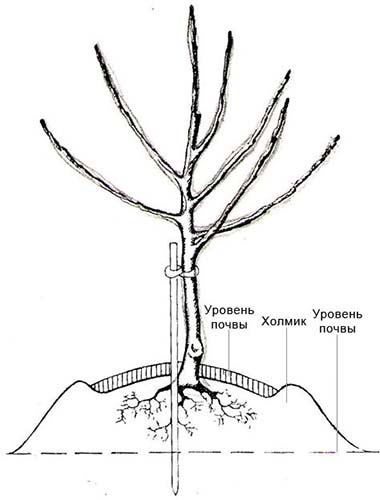
Planting pit preparation: when to dig and what dimensions (depths)
A planting pit for spring planting of cherries must be prepared in advance. It is best to do this in the fall or at least 1-2 weeks before planting the seedling. During this time, the soil will just have time to settle to the desired level.
Important! When digging a planting hole, the top layer of soil is thrown aside for further use.
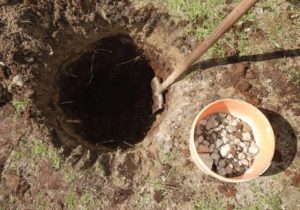
Planting pit width and depth for cherries should be within 50-80 cm (as a rule, on average, they dig a hole of 60 by 60 cm). Moreover, the walls of the recess should not taper towards the bottom, so they should be made vertical.
And here is a planting hole for a seedling closed root just do 2-3 times larger than the container itself.
If necessary, it is immediately laid on the bottom drainage layer 5-15 cm from broken brick or small stones (it is optimal to use lime or chalk crushed stone, which contains a lot of calcium and which deoxidizes the soil = lowers its acidity), and then the prepared nutrient mixture is poured.
Important! If you have to plant in clay soil, then, in addition to the obligatory drainage layer, you also need to dig the deepest hole possible.
How to prepare a nutrient mixture (substrate) or how to fill a planting pit
So that the cherry can easily adapt in a new place and strengthen for further growth, when planting, it is recommended to fill the planting hole with a nutrient substrate, in other words, add the whole complex of macro- and partly microelements.
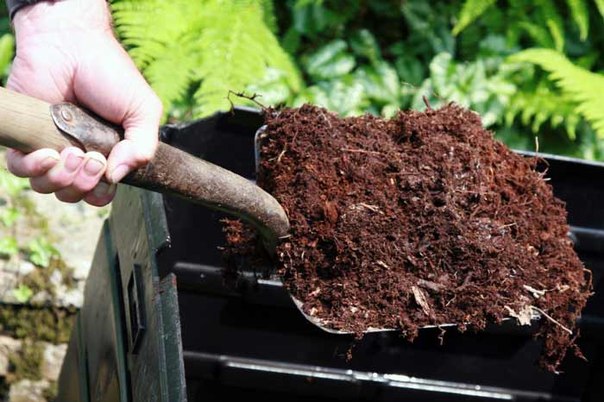
For this, the planting pit is filled with a specially prepared soil mixture (which is thoroughly mixed to a uniform consistency), which may include the following components (mineral and organic fertilizers):
- all horse fertile soil (upper 20-30 cm), which you removed when digging a hole;
- a bucket (8-9 kg) of good humus or compost;
a bucket (8-9 kg) of non-acidic peat (either at will, or in case you have sandy soil);
a bucket (8-9 kg) of sand (if you have relatively heavy soil);
- 1-2 cups (200-500 grams) superphosphate or 400-600 grams of bone meal (organic analogue of phosphorus fertilizer);
- half or 1 cup of potassium sulfate (100-200 grams) or 2-4 cups (200-400 grams) wood ash (organic analogue of potash fertilizer).
Or, instead of superphosphate and potassium sulfate, just use 300-400 grams of nitroammophoska (it contains 16% nitrogen, phosphorus and potassium) or even better diammophoska.

Worth knowing! When planting a tree (even in spring), it is not necessary to specially add nitrogen fertilizers (another thing if it is a complex fertilizer), since they stimulate the growth of the aboveground part to the detriment of the development of the root system (especially when planting in northern regions).
Important! However, many gardeners do not recommend at all to lay mineral fertilizers in the planting pit, but to apply them in the future and already as top dressing.
After filling the pit with a nutrient substrate in its middle, it is necessary drive in a wooden peg, which will further serve as a support for a young seedling.
Step by step disembarkation guide
Step-by-step instructions for planting cherries in spring:
- Fill the planting hole with fertile soil in advance, leaving a depression to the size of the root system of the seedling.
- In the case of planting a seedling with an open root system, add a small mound in the center of the planting hole.
If you are planting a seedling with a closed root system, then you do not need to make any mounds, but simply plant it in a prepared planting pit without disturbing the earthen coma.
- Drive in a wooden support or peg (if you have not done so beforehand).
- Place the seedling in the center of the mound and spread the roots along its (mound) sides down (the roots should in no case bend and stick up!).
Important! If you have a seedling that was grafted with an eye (budding), then the budding site (eye = new shoot that grew from the grafting) should face north and the cut site should face south.
- Cover with earth, while shaking the seedling to eliminate voids between the roots.
- Compact (tamp) the soil, starting from the edges at the base of the seedling.
At the same time, do not confuse the root collar (the place where the first root originates from the trunk) with the grafting, which is higher and should be located 3-5 cm (you can simply attach 2-3 fingers) above the soil surface. After the tree settles in loose soil, the root collar will in any case take its normal position.
Attention! But if you deepen the root collar, then the tree will grow poorly and gradually die (because the root collar will shake out). On the contrary, plant it too high, the roots of the seedling will be exposed and may simply dry out in the summer heat or freeze out in winter.
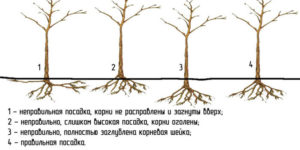
- Next, you need to make a hole (roller) along the diameter (perimeter) of the trunk circle 5-10 cm high.
- Spill abundantly with water, pouring out at least 2-3 buckets (pour out gradually - wait for it to be absorbed and add more).
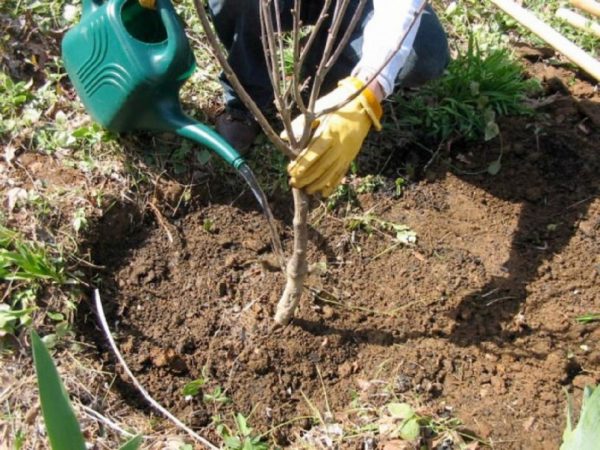
- Tie the seedling to the prepared support with a soft twine and secure in the correct position.
- Smooth out the roller, loosen the soil in the near-trunk circle and mulch it with peat, humus or compost.
Mulch will help prevent dry roots and excess moisture evaporation.
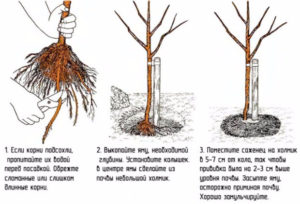
Worth knowing! Mulch should not be laid close to the trunk of the seedling, as this can cause the bark to undergo heating, and, consequently, cause the development of fungal diseases.
Video: how to plant cherries correctly
Further care for cherries after spring planting
Immediately after planting, the cherry seedling must trim, in order to level the root system with the aboveground part (this is done for a kind of "resuscitation" of the seedling after planting, since any planting and transplantation is an injury and stress for the plant).
How to do it correctly (start shape cherry), read in our article on spring pruning of cherries (for cherries, everything is the same).
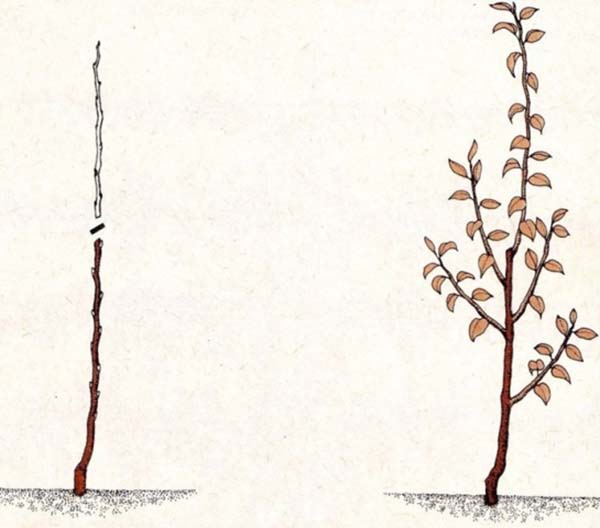
Further, a young tree will need careful post-plant care from you, aimed at creating optimal conditions for its early survival in a new place.
Video: basic rules for planting and caring for cherries
It can be stated with full confidence that the main condition for the successful rooting of cherries is a sufficient amount of moisture in the soil. Therefore, if the weather is dry, then after planting, timely and regular watering should be carried out (1-2 times a week), pouring out 2-3 buckets of water. In the future, watering will need to be carried out as needed, depending on weather conditions (in spring and autumn, you can water it 2-3 times a month, and in a hot and dry period - once a week). And then (after each watering), if you did not mulch the near-stem circle, be sure to loosen the soil at the base to improve oxygen access to the roots. It is also recommended to simultaneously weed out the weed circle.
By the way! It is very simple to determine that the earthen lump is dry and the cherry urgently needs watering: you dig a hole deep into the bayonet of a shovel, take a handful of earth from the bottom, if it is dry, then water it urgently.
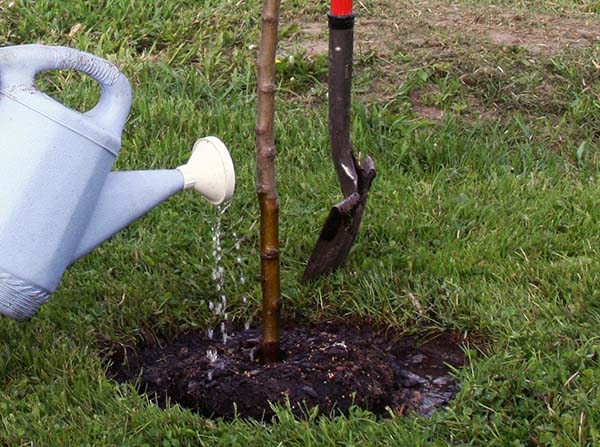
Advice! Either make a new hole every year, or initially dig not very deep so that moisture does not accumulate in it in the winter-early spring period and the root collar does not get wet.
Additional dressings during this season, it is no longer necessary to carry out, since all the necessary nutrients were introduced during planting, and they should also be enough for the next few years (2-3 years).
Of course, you need to carefully monitor the condition of your tree so that it is not suddenly struck by any diseases or pests.
The main scourge (the most dangerous and annoying disease), which often affects cherries (however, like cherries) is coccomycosis.
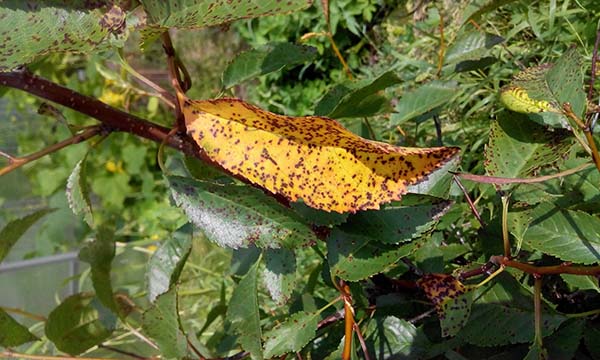
By the way! The site has a detailed article about how to properly spray cherries and cherries in the spring against diseases and pests.
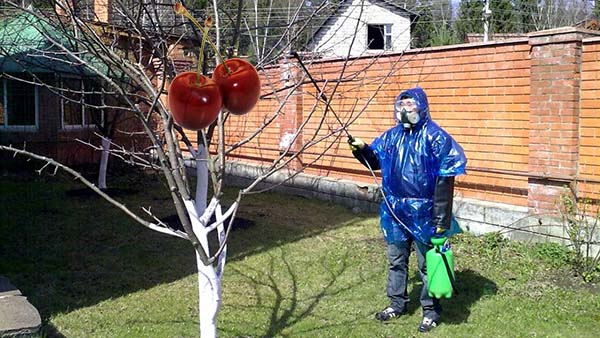
Also, don't forget correctly prepare (cover, mulch) cherries for winter.
And next spring, you will again have to perform a series of simple activities to care for your stone fruit crop.
By the way! The site has a general article about spring cherry care.
Thus, the correct planting of cherries in spring is a guarantee of their future health, which in the future you will be able to "build up", creating favorable conditions for its (cherry) growth. And only then, in a few years, she will certainly thank you with the first and not the last harvest.
Video: the correct planting of cherries - how to choose a seedling and a place in the garden for planting and further growing

